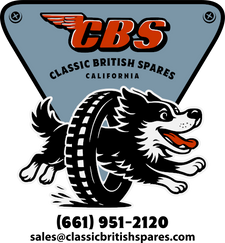
No Gasket Required? - Seal It Up With Yamabond
British bikes have rightfully earned some popular nicknames, slogans and jokes throughout the decades that most can understand and relate too
Slogans like some of the following..
- "Oil Bath"
- "If its not leaking then theirs no oil in it"
- "All British bikes mark there spot"
I'm sure theirs many others I missed but on a more serious note, I wanted to take the time today to talk a little bit about a sealer that we use here at the shop very frequently
This sealer is called Yamabond (#4)
Over the years I have tried many brands of sealers, however, since using Yamabond #4 I have been getting positive and lasting results
If you're unfamiliar with Yamabond #4, stick around and I'm sure by the end of this post, you may want some Yamabond #4 sealer in your workshop or next engine build
Lets dive in
Getting to know "Yamabond"

Below I will cover some info specifically on the Yamabond #4 sealer and also cover some points that make Yamabond my first choice
Yamabond is a form of grey colored silicone manufactured by Yamaha used to dress engine cases, gear boxes and other surfaces that require sealing with no gasket
For example, if you happen to building a Triumph unit 650 motor, you would use Yamabond #4 on the crankcase halves, inner and outer gearbox cover and the timing cover where a gasket was not fitted with from the factory...
Non-setting

Most folks these days tend to run away from using silicone in an engine (especially in the classic British motorcycle community) however, Yamabond is "non-setting"
Non-setting is extremely important as the Yamabond sealer will not harden or set but will continue to seal and stay "soft"
Sealers that harden can break off and cause engine failure due to plugged oil ways, pumps, etc if used the incorrect way
Fills gaps

Should you have a flat surface with imperfections including dings, scratches or gouges, Yamabond will fill any void on surfaces up to .025" deep
If you cant lap or mill your gasket surface, Yamabond is a great choice
Doesn't run

Some sealers on the market today are often too thick and to runny - Yamabond is the perfect mix of thick and thin making the blend easy to work without making a mess all over your parts
Easy to apply and can be done so in a quick manner
Dries in a reasonable time
When applying Yamabond you will have enough time to do your entire part and not have to worry about it setting only to find that your job is half done
With Yamabond you can take your time to ensure the job is sealed correctly
Takes approx 1 hour for the sealer to be used and 24-hours for the sealer to cure
Easy to remove

If you want to know how good (or bad) a sealer is, see how easy / hard it is to remove once the sealer has cured
Yamabond #4 can be removed very easily
Just a small amount of Aceton or simply "rub" the sealer off with your index finger or finger nail
Oil friendly
We have found that Yamabond works great even when surfaces are not perfectly cleaned or prepped
Sometimes when your working on an engine and time is limited, we have found that Yamabond stills seal well under conditions where oil or residue is still present on the mating surfaces
How to properly use Yamabond
The key to a successful seal and bond that will prevent future leaks or weeps is all in the preparation
I will cover the steps that Kyle and Malcolm like to perform in the workshop when applying Yamabond

- Make sure all surfaces are flat and clean (use acetone or alcohol to clean surfaces)
- Apply a conservative amount of sealer on both surfaces (thin amount)
- Wait approx 1 minute to allow both surfaces to become "tacky"
- Join both surfaces together using hardware to secure
- Allow parts to cure to for at least 1 hour before use
- Clean up any residue left behind
Ready to seal the deal?
Want to give Yamabond #4 a try on your next engine build?
Click on the link below to purchase your new genuine Yamabond #4 gasket sealer today
| Brand | Gasket Type | Sealer Color | Specs | Link |
| Yamabond | RTV Gasket Sealer | Grey | Semi-Drying | Click here |
Thanks for reading today
Thank you for reading today's post
Should you have any questions please drop us a comment using the section below
Click here for more blogs, tech and other useful information and tips
Ride safe!

Classic British Spares
@Mitch – agreed
Mitch Burk
I believe Yamabond, Hondabond and 3bond are all the same gray sealer. I’ve used Hondabond and 3bond and I know they are the same. I’ve built 4 Commando engines and used it to seal the cases together with no gasket. None of them leak. I’ve also used it on covers and other places. It can be a bear to break a cover open which has it on both sides of the gasket. If you are doing a cover that may get removed like a primary, only use it on one side of the gasket and grease on the other.